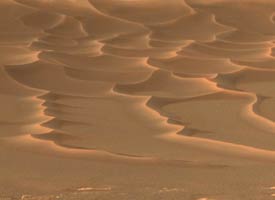
Opportunity imaged, but dared not enter, the sand dunes at the bottom of Endurance Crater.
Courtesy NASA / JPL / Cornell University.
When astronomers look back on 2004, it will be remembered for long-awaited space missions, political controversy, and the arrival of an astronomical event never seen by living eyes. It certainly began with a bang. In January, two events rocked the scientific community and continued to reverberate throughout the entire year: NASA's Mars Exploration Rovers successful mission to Mars and NASA's announcement that the Space Shuttle would no longer service the Hubble Space Telescope.
The first Mars rover, Spirit, reached the planet on January 3rd; its twin, Opportunity, followed three weeks later. Designed with a 90-day shelf life, both vehicles long outlived their warrantees and continue to operate. The thousands of images they sent back to Earth told the story of Mars's watery past. And the evidence was overwhelming. Seemingly everywhere that the rovers' instruments examined, they found minerals which had formed in water — not just ancient puddles, but lasting shallow seas. The rovers continue to trundle on through the Martian winter. Who knows what they will discover in 2005.
When NASA administrator Sean O'Keefe declared that having the Space Shuttle visit the Hubble Space Telescope was too dangerous, he sentenced the beloved telescope to a premature death in orbit. Although some scientists acknowledged the logic behind trying to insure the safety of astronauts following 2003's Columbia disaster, others deemed the measure too draconian. While the public, politicians, and the media condemned the decision, Congress and NASA commissioned studies to assess the various options available to save Hubble. Late in the year the the leading panel concluded that Hubble deserved the chance to live. Whether astronauts will visit Hubble again remains to be seen. But for now, the Shuttles still aren't flying and O'Keefe has resigned.
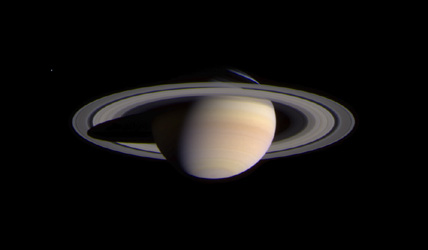
The glory of Saturn's rings as seen by the Cassini spacecraft.
Courtesy NASA / JPL / Space Science Institute.
After seven years in interplanetary space, NASA's Cassini spacecraft began orbiting Saturn in July and earthlings became mesmerized by the detailed views of the planet's rings. More pictures of Saturn's many moons will come over the next four years of operation. But one of the most anticipated planetary-science events will happen in a couple of weeks. On December 24th Cassini successfully deployed the European-built Huygens probe that will plunge into the atmosphere of Titan on January 14th.
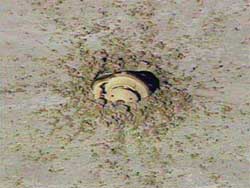
When its parachutes failed to deploy, the return capsule of the Genesis spacecraft crashed into the Utah desert.
Courtesy NASA.
A bevy of other spacecraft reached notable achievements during the past year. Gravity Probe B is finally monitoring the warping of space-time to check Einstein's theory; its initial results are expected next year. The Swift spacecraft will soon make fast detections of gamma-ray bursts. The Messenger spacecraft is on its roundabout way to Mercury. And Stardust is bringing back samples of Comet Wild 2 collected on January 2nd. When the return capsule is dropped off at Earth in 2006, researchers hope it won't meet the same fate as the Genesis spacecraft, which crash-landed in the Utah desert on September 8th.
There's been plenty of spectacular findings made with ground-based instruments too. Astronomers have spotted giant objects in the distant reaches of the solar system. In February, a research team announced the discovery of an object designated 2004 DW, a minor planet about two-thirds the size of Pluto orbiting beyond Neptune. Less than a month later, the same astronomers brought us more-remarkable Sedna, whose 12,000-year-long orbit takes it farther away from the Sun than any known object.
Astronomers also detected yet more planets around other stars. Some of these new worlds are only the size of Neptune, which instills hope that Earth-size objects will eventually be found. Furthermore, infrared observations with the Spitzer Space Telescope are revealing how planetary systems form.
Not all of 2004's astronomical excitement was about cutting-edge discoveries. Amateur observers had much to enjoy in with their backyard optics. In January, Kentucky amateur Jay McNeil noticed a glowing cloud of gas near Messier 78 in Orion that wasn't there the last time he looked. "McNeil's Nebula" became the talk of the town as amateur and professional astronomers alike took an interest. It turned out that the nebula bloomed as a shrouded star had an outburst, an event that had happened before but went
unnoticed.
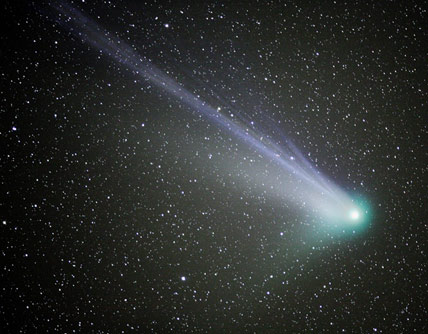
David Harvey took this image of Comet NEAT (C/2001 Q4) on the evening of May 13, 2004.
Photo by David Harvey.
And comet-lovers had their skies full, as a record-breaking five cosmic interlopers reached naked-eye visibility (best seen from a dark sky). Comets NEAT (C/2001 Q4) and LINEAR (C/2002 T7) reached 3rd magnitude in April and May. Comet Bradfield (C/2004 F4) peaked at 2nd magnitude a little before them while close to the Sun. Another comet from the automated LINEAR search project, C/2003 K4, barely crossed the edge of naked-eye visibility in July. And the year ends with Comet Machholz glowing better than 5th magnitude and should brighten a bit more by early January.
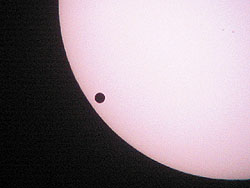
Sky & Telescope's editor-in-chief captured this image of the transit of Venus shortly after second contact from the Arcetri Astrophysical Observatory in Florence, Italy.
Sky & Telescope image: Richard Tresch Fienberg.
The sky gave observers something to watch in the daylight too. Topping the list of anticipated events for many astronomers was the first transit of Venus in more than a century. Although the event was visible from the eastern United States at sunrise, many observers made special effort to watch from more promising locales in Europe — few were disappointed. If you missed the transit, you'll get one more shot to see one in June 2012.
May your skies be clear in 2005!
 0
0
Comments
You must be logged in to post a comment.